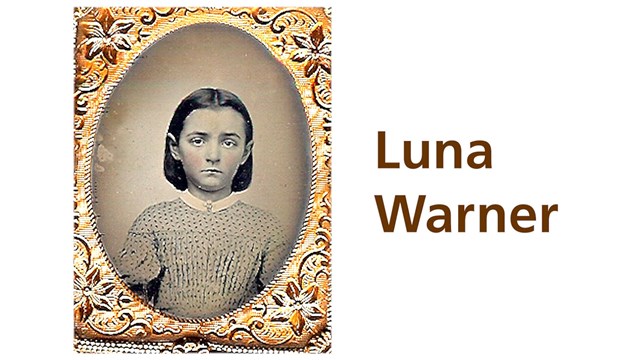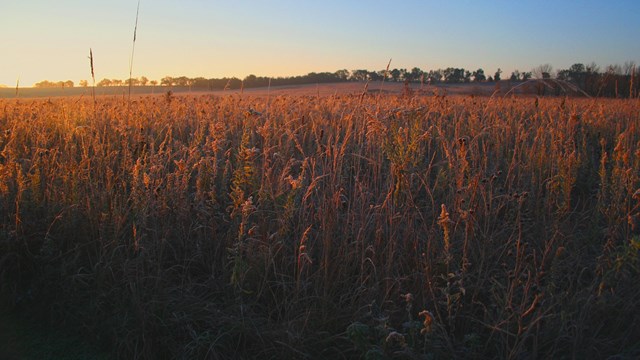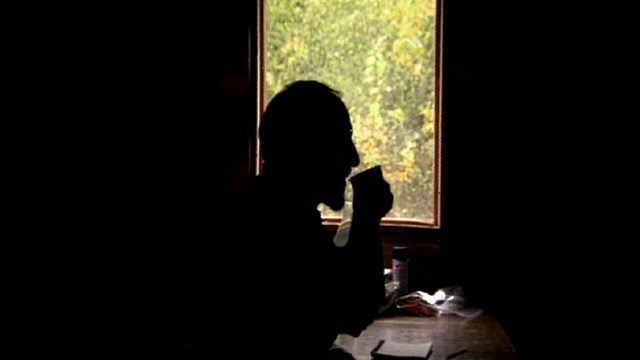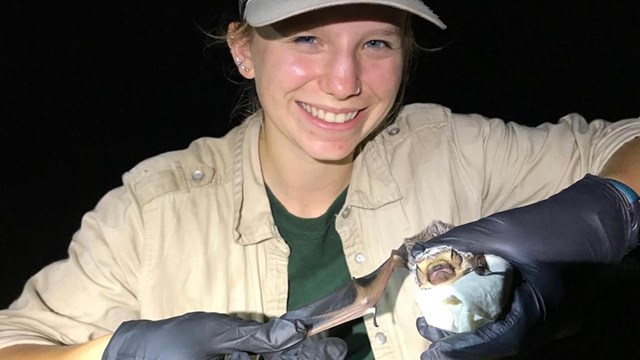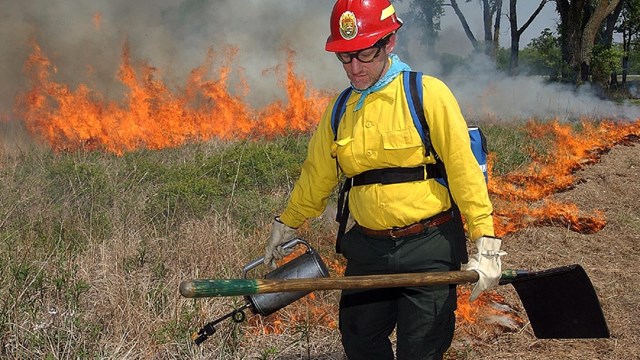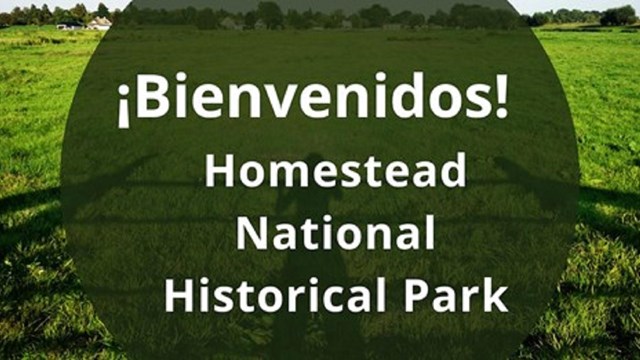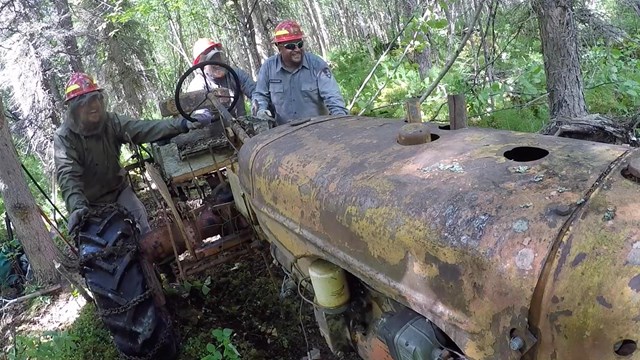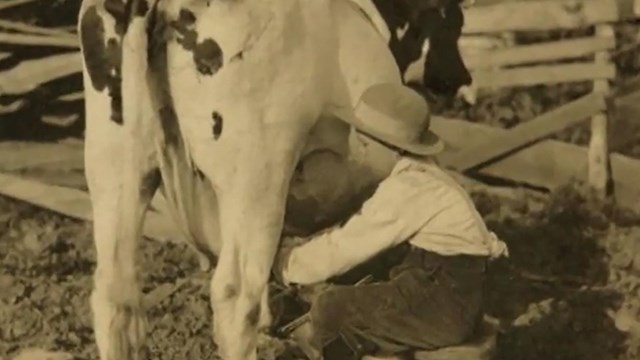Good afternoon folks! Thanks everybody for coming out today to Homestead National Monument of America.
My name is Todd Arrington. I'm the park service historian here at Homestead National Monument of America. And we're going to be talking today just for about 25 or 30 minutes about the Oklahoma Land Rush.
The reason that we decided to do this program now is that we’re actually coming up on the anniversary of the first Oklahoma Land Rush which was April 22nd of 1889. And we are-- so we're kind of coming up on that anniversary and it was a very convenient time to do this type of a program.
So the history of the Oklahoma Land Rush actually doesn't begin in 1889 it actually goes all the way back to 1803 which was the date of the Louisiana Purchase. And this of course was the famous purchase of the entire Louisiana Territory made by the Thomas Jefferson administration from Napoleon Bonaparte and the French government.
Jefferson had actually sent emissaries to Paris not to buy Louisiana, but really to buy just the city of New Orleans which of course we all know is sort of at the bottom of the modern state of Louisiana. And the city of New Orleans was important because it basically controlled commence on the Mississippi River.
And if Jefferson was going to expand the country and he was going to expand commercial opportunities for the United States he really needed to have American control of New Orleans. So he sent emissaries to Paris really to negotiate for the purchase of just the city of New Orleans. And he managed to get the Federalist nominated Congress to agree to spend up to 9 million dollars for the city of New Orleans. Well when his--the dignitaries, the Americans, got to Paris Napoleon actually, sort of, counter offered with--for 15 million dollars he'd sell the entire Louisiana Territory. Not just the city of New Orleans, but the entire territory. About 820,000 square miles for 15 million dollars.
And so of course, 1803 being 1803 there wasn’t any opportunity to send Jefferson an email or call him on his cell phone or anything [chuckle] like that.
So these emissaries really were faced with a difficult decision which was: do we really have the authority to basically say yes we’ll give you an additional 6 million dollars over what we'd been authorized to spend.
But fortunately, they decided it was a good deal and they just agreed to it. And fortunately, Jefferson was pleased. And although I don’t think he relished the idea of going back to a Federalist Congress that really didn’t like him very much and asking for another 6 million dollars. But anyway, they did purchase Louisiana for 15 million dollars. It worked out to about 3 cents an acre. Which even in 1803 was not a bad price for real estate.
So out of that roughly 820,000 square miles of Louisiana Territory about 70,000 square miles is what we now call the state of Oklahoma which is right here [pointing to a map]. And so the entire--what we now think of as the state of Oklahoma was part of the Louisiana Purchase as was Kansas, and Missouri, and Arkansas, and Nebraska, and then South Dakota, Iowa, and lots of other areas that we're familiar with today. [clears throat]
So this is really where the history of the land rush really begins, not in 1889 but in 1803. Now there were five so-called “Civilized Tribes” that were directly affected by the Oklahoma Land Rush. In the 1820s and 30s these tribes of course lived on their traditional homelands which were primarily in the Southeastern United States: Tennessee, the Carolinas, Georgia, Mississippi, Alabama those types of places.
And they were called civilized tribes, quote unquote, because they had actually by this time the 1820s and 30s, adopted a lot of sort of Euro-American traditions and customs. They basically had begun to try to assimilate into the mainstream of American society. A lot of them had written constitutions. They had legal systems. They had--some of them even had slaver which was obviously very, very common in the Southern United States at this time.
So they had sort of become known as civilized tribes because they were kind of basically like--trying to be like the Americans. But in 1830 Andrew Jackson was President and he signed an Indian Removal bill that basically kicked these tribes out of their--these traditional homelands because they lived on very good farmland.
And they were--a lot of these were agricultural tribes. But they lived on good farmland and all of the white farmers around them wanted that land. And they began to put pressure on their elected representatives to-- to stop wasting good land on Indians, basically is how some people put it.
And so Jackson of course was very forceful about his opinions about the superiority of the white man over the Indian and over the African American. And he very happily signed the Indian Removal bill in 1830 which took these tribes out of the Southeastern U.S. and then moved them out into a barren, desolate wasteland that they called Indian Territory and that we now call Oklahoma.
This is where we get the--sort of the famous Trail of Tears. Where these tribes were forcibly removed out of the Southeast and moved out to Indian Territory in Oklahoma. And certain tribes are--sort of have more well-known or more famous Trails of Tears. Really in reality all five of these tribes had their own kind of Trail of Tears because they all made these, sort of, long sojourns out of the Southeast to Oklahoma on foot or on horseback. A lot of them took place in the winter. And a lot of--some tribes lost up to 30 or 40 percent of their populations on these treks from their homes to the Indian Territory.
So the Trail of Tears is kind of spoken of as one sort of big, large event, but in reality it was many, many different events. And it is of course this is Andrew Jackson down here in the corner. [points at presentation]
So Jackson is really regarded in mostly--by most historians as a very effective President, as a good President. But this is of course one area of his record or his administration that his administration that perhaps is not seen quite as positively now as it once was.
The tribes as again--as I said were put out into this Indian Territory as it was called, what we know call Oklahoma. And they were told that the lands will be theirs as long as the stars shine and the rivers flow. So basically, the government was making a promise to them that they would be on this land forever. This was now their land. Sorry we had to kick you out of the other place, but you’re here now and you can stay here forever.
And of course, American Indians were very familiar with promises from the U.S. government [audience chuckles] that were not often honored. And sure enough by 1887 things began to change for--not only for these tribes, but for natives all over the country with the passage of the Dawes Act.
And so I kind of tongue in cheek here say ‘the stars stopped shining and the river stopped flowing.’ That actually is almost quoted from a gentleman that speaks in the new film. So if you want to see that afterwards we’ll be happy to show that again.
The Dawes Act and this is Henry Dawes up here in the corner [pointing at presentation]. He was a senator from Massachusetts. The Dawes Act basically was sort of thought to be an Indian Homestead Act. And the idea was that instead of massive sort of communally owned tribal reservations, each head of household and each head of each Indian household would be given 160 acres just like a homesteader.
And this would then sort of begin to encourage them to assimilate more quickly into American society. Basically, it was an effort to turn them into Christian farmers in, sort of, the American tradition of farming. A lot, as I said before, a lot of these tribes were agricultural even before they came to Oklahoma. But they farmed differently; their farming practices were different.
Certainly, their ideas of land ownership were very different than the U.S., than the mainstream of U.S. society. Most American Indian cultures didn’t really view land as something that could be owned by an individual person; it belonged to everybody. And so--but then of course then you have the complete opposite of that is the Homestead Act where people are specifically working to get their own 160 acres. Their own kind of little piece. And say--they can say, ‘this is mine and that’s yours.’ And that is certainly not the way that most American Indian cultures viewed land ownership.
So anyway, the Dawes Act was designed, and then again not just in--for Oklahoma, but for the entire country to basically hasten the civilization so to speak of American Indians. But of course, if you take each head of household on these reservations and you give them 160 acres at the end you’re going to have a lot of land left over that suddenly these Indians don’t need, right. Because we've taken so much land. You've--they’ve all got their 160 acres and now there's millions of acres of excess.
And what are you gonna do with that land? Well of course you’re going to open it up to farmers. Now in Oklahoma, the five tribes, the Five Civilized Tribes didn’t actually have to adhere to the Dawes Act until after the turn of the 20th century. But the writing was on the wall for them. And they kind of started to think that maybe they needed to start figuring out what they were going to do with their land because they knew that eventually they were gonna lose it if they didn’t do something.
So a lot of them began to think about selling land or ceding land to the U.S. government trying to get anything they could for it, basically. And you can see here [on the presentation] the Creeks and the Seminoles in fact sold nearly 200 million acres of their Okla--their lands in Oklahoma to the U.S. government. Some of the other tribes ceded land to the government. Some of them were involved in treaties with the government about how the land would be used and who would get acess to what land.
And again, treaties with the government, as far as American Indians are concerned, were not necessarily worth the paper they were printed on. So a lot of these lands that had been sold back to the government or had been ceded to the government were then designed to be opened up to settlement by white farmers, by homesteaders.
That’s something that a lot of people don’t realize when you talk about the Oklahoma land rush, is that these people, they were homesteaders. They were going after lands that would be opened up under the Homestead Act. [clears throat]
Now we see here, and I actually have a typo in the--in one of the statements here that these lands opened to settlement by Indian Appropriations bill signed on May--March 2, 1889. It actually was not signed that day it was actually passed by Congress that day. And this gentleman down here [points at presentation] Grover Cleveland, who was President of the United States on March 2, 1889. And on March 2, 1889 Grover Cleveland had exactly two days left in his administration because on March 4, 1889 this gentleman [points again] became President, Benjamin Harrison.
And basically, Harrison had this Indian Appropriations bill basically handed to him. It had already been passed by Congress. Cleveland had basically said he thought it was a good idea. And so it lands in Harrison’s lap and he signs it on March 23, 1889. And basically, it says that almost 2 million acres of land in Oklahoma is gonna be open to settlement because these tribes have turned these lands back over to the U.S. government. And they are now encouraging white settlers, white homesteaders to come and actually take land in Oklahoma.
April 22, 1889 was the day that bill set for the day that those lands would officially be opened. And they would be officially opened at noon. And so why they chose April 22nd, I don’t know. I know it was a Monday maybe they just wanted to start the week off right. I’m not sure. But at any rate April 22, 1889 was the day that was chosen as when these lands would become open.
It was a little different then for-- like sometimes when people come here to Homestead [National Monument of America] they think Daniel Freeman who homesteaded this property where the park is built. Did he have to make a land rush? And the answer is no. He was here. And on January 1, 1863 when homesteading actually went into effect there was just so much land. That there was nothing like this where everybody was lined up waiting for midnight. It was nothing like that. Because there was so much land and really so few people that were out here to take advantage of it.
Well by 1889 everybody knew about homesteading, everybody wanted land, everybody knew that all this land was gonna open up at noon on April 22nd. So you can image what happened. That all these people just made this mad dash for Kansas, and Texas, and Arkansas, states that border Oklahoma to get ready. To be there to get land on April 22, 1889. So it was a very different situation than what happened in most areas of country. And there really weren’t that many other cases, that I’ve read about at least, in other parts of the country where something like this happened. Where a very specific piece of ground was opened up on a very specific date, at a very specific time.
So this is kind of a--sort of an anomaly in homesteading history as far as I can tell. So a lot of these sort of border towns on--in these other states like Kansas and Arkansas and Texas really sort of ballooned in population. And because all these people sort of showed up out of nowhere to start getting ready for the land rush. Some of these little towns that had 50 or 100 residents suddenly had 20 or 30 thousand.
And so of course you can imagine what kinds of businesses were opening up. Saloons and that kind of stuff were opening up on every street corner to keep people occupied and to keep 'em busy until April 22nd.
One of the interesting things about Harrison’s proclamation was that he did specifically state in the proclamation that anyone that went into the land that was gonna be opened on April 22nd before the land was officially opened. Whether it was three weeks before or three minutes before would not, if they were caught of course, would be kicked out and would not be able to come back to take a homestead there.
And so they were trying to make sure that nobody got in there illegally. Basically to get land unfairly. And those are people that of course became known as the Sooners. Because they go in too soon. The people that were there in the saloons and all these other places waiting for the rush, that were all high on going into Oklahoma were Boomers.
They were Boomers for Oklahoma. But the people who went in too soon were the Sooners. So just to make this a little [laughs] make it a little--put it in a language everybody can relate to Oklahoma football has this whole thing about Boomer Sooner. Well this is where the Boomer Sooner comes from. The Boomers were the people that were gonna be taking land legally. And the Sooners were the ones that were gonna be taking it illegally. So anyway this is--my office mate is an Oklahoma grad so she was very happy to see me put this in the PowerPoint.
But the next time you're talking to Oklahoma fans let 'em know that their name-- their team's named after a bunch of cheaters. They’ll like that a lot. [chuckles]
They are pretty serious about football down there too. So anyway, so before the rush you have, like I said you have these massive--this massive influx of people coming into these towns. And lots of violence and lots of other sort of questionable things going on. Because it's just all these people crushed into these very small spaces.
The army is actually sent in. Some cavalry units from the U.S. Army are sent into the lands that are gonna be opened up. Not only to maintain--try to maintain law and order to try to keep out Sooners. But also, to help with surveys. One of the provisions of the Homestead Act was that you can only homestead on land that had been surveyed.
And that’s--the surveys were important because that is how the government kept track of who was where and what was available and what wasn’t available. So the land did have to be surveyed prior to someone taking a homestead on it.
But of course, how do you survey 2 million acres of land in five weeks? Well there's not that many surveyors in the U.S. government so they actually send the army in to help with the surveys. So you can imagine how some of those surveys looked like. [audience laughs] They probably were a little cattycorner because these guys are trained in cavalry tactics, they're not trained to be land surveyors. So there probably were some pretty interesting looking maps there.
This is just a photo here of kind of what a land office. [points to presentation] I don’t even know if it is from Oklahoma. It’s just to give you an idea of what land officers were and what they were all about. They built two--initially built two land offices at Guthrie and Kingfisher. Although really those areas barely existed. I mean they were just dots on a map. There may have been one building here and one building there. But they weren't--it’s not like there were big towns or anything in Oklahoma Terr-- in the Indian Territory. They would soon become big towns of course because of the rush. But those-- that’s where the first two initial land offices were built in the territory. To get ready to start taking in these massive numbers of homestead claims. Because when people made a homestead claim, whether it was in Oklahoma or anywhere else. Once they decided where they wanted to go, they had to go to that land office and fill out paperwork.
And so those land offices were going to be very important because for the homestead to be legal all of the paperwork had to be done. So those land offices in Guthrie and Kingfisher and other places later on would be very important.
As I said, the border towns kind of got crowded with all of the Boomers getting ready to make the land rush. Roughly 12,000 quarter sections or twelve thousand 160-acre plots of land were set to be available on April 22nd and there were approximately 50,000 people there vying for them. So I’m not-- wasn’t much of a math major, but you know it doesn’t take a genius to figure out that most people that are gonna be making the land rush are not gonna get land.
And so then some of these ruffians that were hanging out in the border towns waiting for the land rush were armed to the teeth with pistols and knifes and all this. And then 160 acres or six feet they didn't-- nobody cared. I don’t give a damn which. So it's they’re either gonna get land or they are gonna get killed. Either way they’re happy [chuckles] I guess.
The rush itself again by early morning on the 22nd people were starting to line up and then by 9 AM or so, somebody was saying the sound wasn't human at all, but like thousands of wild animals penned up. All the people, all the conversations, all the horses and you can just imagine. People were able to go into Oklahoma on horseback, on foot, in wagons.
And then they did something that I think is pretty interesting. They actually allowed a number of trains to go in as well because there was train track that had already been laid into Okla-- into the Indian Territory. And they determined that since not everybody had access to a horse or a wagon or something like that, they would allow trains to go in, but they could only go 15 miles an hour maximum because that's about the rate that the horse can run.
So there actually were people that were going into Oklahoma on trains. So that’s pretty interesting. And there's a photo here that I’ll show you later on that actually shows you some of the trains in the background. That’s really neat.
So anyway, at noon on-- they blew the-- they blew revelry on the bugle and the rush started. And these are just a couple photos here [on the presentation]. This one here on the left is actually right before the rush people just standing around. And then obviously the one on the right here is shortly thereafter. [chuckles] After the bugle had blown and people were actually, literally in the process of making the rush.
So there have been lots of movies that depict the land rush. And you know this is one-- this is one of those rare episodes in history where Hollywood has kind of gotten it right actually. Which doesn’t happen very often, but because they usually just portray it as this mad dash and it’s just noise and dust and violence. And I think that's really pretty much how it was based on everything that I can-- that I’ve done for this.
There was a movie, I don't know 15-16 years ago [1992], Far and Away. Anybody remember that? Had Tom Cruise and Nicole Kidman. I’ve seen lots of pictures of homesteaders, none of them looked like Tom Cruise and Nicole Kidman. [audience laughs] But anyway. [chuckles]
This whole movie was about these Irish immigrants coming to the United States and at the end of the movie-- the climax of the movie is they make the Oklahoma land rush. And of course, they get land.
And it's very violent. I mean there are people hitting each other, riding on horseback whacking each other with sticks. And you see people in the background getting shot. There's claim jumpers, this guy has made his claim and somebody else comes along and wants it so they just blow the guy away. It's very, very, very, very violent.
Couple of good quotes for you here about the rush. This is from Harper's Weekly just a few weeks after the land rush. This was from a someone-- a reporter that was actually there to see it.
"The sweet notes of a Calvary bugle rose and hung a moment upon the startled air. It was noon. The last barrier of savagery..." That being the Indians of course. "...in the United States was broken down. Moved by the same impulse each driver lashed his horses furiously. Each rider dug his spurs into his willing stead. And each man on foot caught his breath and darted forward. A cloud of dust rose when the home seekers-- where the home seekers had stood in line. And when it had drifted away before the gentle breeze, the horses, and wagons, and men were tearing across the open country like fiends. The horsemen had the best of it from the start. It was a fine race for a few minutes, but soon the riders began to spread out like a fan. And by the time they had reached the horizon they were scattered as far as the eye could see. Even the fleetest of the horsemen found upon reaching their chosen localities that men in wagons and men on foot were there before them. As it was clearly impossible for a man on foot to outrun a horseman the inference is plain that Oklahoma had been entered hours before the appointed time." There's your Sooners.
"Notwithstanding the assertions of the soldiers that every Boomer had been driven out of Oklahoma. The fact remains that the woods along the streams within Oklahoma were literally full of people Sunday night." Which was the night before. "Nine tenths of these people made settlement upon the land illegally. The other tenth would have done so had there been any desirable land left to settle upon."
So that's a good sort of description. Not only of the rush itself, but also the fact that a lot of those Sooners had not gotten caught and were there illegally.
Here's a-- let's see. Here's a good one about the trains. "There was a loud whistle from the engine answered by a shout from the train and we were in Oklahoma. As we crossed the line, squatters sprang out of the woods on every side and it was evident from the appearance of some of them that they had been in hiding for weeks. What happened when the train began to slacken at Guthrie beggars all description. Boys, middle-aged men, and old fellows threw themselves off the platform and commenced a wild rush. Some carrying their grips and others dropping everything in the eagerness of the chase. Each man as he found an unclaimed lot preceded to stake it out and hold it down. By the time the men on train number one had each selected his lot the townsite had extended away beyond the half-section reserved. And long before the majority had quit running, train number 2 pulled in quite as heavily loaded as its predecessor."
And then one last from the Manhattan Kansas National List, another newspaper. "Then people went out like flies out of a sugar casket. In five minutes, a square mile of the prairie was spotted with squatters looking like flies on a sticky paper. A large number of women were among the company and among these we noticed one who hobbled on a crutch. There was a continuous line of vehicles like the supply train of an army. The line was continuous for many miles and the dust rolled over them and all were of one color of grime. We passed populous towns built in an hour whose thousands must have had a distressful night on the bare earth. We had seen the sight of the century."
So, there's a few good quotes sort of about the madness and the chaos of the land rush. Just a few-- another good quote here. "Unlike Rome, the city of Guthrie was built in a day." [audience laughs] That's from Harper's Weekly right after the land rush.
And then really, almost literally by the night-- the end of the day on April 22nd all of these towns that are still in existence in Oklahoma were-- had been begun. Because so many people had just made this massive influx into Oklahoma all in one day. Oklahoma City and Norman and all these other areas that are still in existence. So that's pretty interesting.
There's another good story that I read in here too about this issue of the Sooners going in before they were allowed to be there. One guy talked about he was making-- he was legal. I mean, he had gone in at noon, and he got to a place and there was a guy already there who had already plowed a field. And already had onions coming up out of the ground. [audience laughs]
And so, the first-- the legal-- the Boomer, the legal guy says 'Well, what's this all about?' And the guy says 'Oh I've only been here fifteen minutes. The soil here is so good...' [audience laughs] 'That these onions have just come up. It's magic.' [chuckles] So anyway.
So that just-- obviously these quotes and these stories they really do kind of speak to a few different issues involved with homesteading. One is there was a good amount of fraud involved in homesteading. A lot of people did make claims, not only in Oklahoma, but in other places illegally.
And then the one quote here talks about that there were a good number of women. Women could be homesteaders. Single women, widows, divorcees, what they called deserted wives whose husbands had run off on them. They could all be homesteaders. A married couple couldn't have two homesteads, but women could be homesteaders. And that was pretty progressive for the 1860s and '70s and '80s. Long before women could even vote. That they could be homesteaders.
And so, we know based on this evidence that there were women making the Oklahoma land rush as well. I know-- I read another good one about a lady that ended up in one of these border towns before April 22nd. And she was a widow and she had children-- oh no, she met a guy who had-- who was a widower and had some children with him. And they made a deal that he was gonna make the rush if she agreed to stay there in Arkansas City or wherever it was, one of these border towns and watch his children. If he got land, he would come back and marry her. And sure enough, he came back and they got married. [audience laughs] So, go figure.
Necessity is the mother of invention they say. So he needed somebody to take care of the children and she needed a way to get some land in Oklahoma and it all worked out. Anyway, I'm not sure how many of those stories there are. Or how many of those cases there were, but it certainly did happen.
So after the rush, I mean obviously Oklahoma is established relatively quickly. Here you can see Oklahoma City talking about how much-- how many professionals they have here just shortly after the rush. 53 physicians, 97 lawyers, more lawyers than anything, go figure. 47 barbers, 28 surveyors, 29 real estate agents, and 11 dentists. So obviously they are cosmopolitan society with all of these professionals hanging around.
And they began to really-- they began to build up-- build the area up and by May 2nd of 1890 Oklahoma territory was officially established by the U.S. government.
The 1889 rush is the most famous because it was the first, but it was not the only Oklahoma land rush. In fact, there were five total there were four more after the 1889 rush. In 1891, 1893, 1901 and 1911 there were additional land rushes.
This photo here [points at presentation] is actually from the September 16, 1893 rush which was for the Cherokee Strip which was a strip of land up in-- sort of in northern Oklahoma near what we think of now is the Panhandle. That rush had over 100,000 people so actually that 1893 one was larger than the 1889 one. But the 1889 is the most famous because it was the first.
The first three, the 1889 the ‘91 and the ‘93 they used basically the same system they used in-- that we've been talking about where people just lined up and they just blew the bugle or the cannon and people just made a mad dash and got whatever they could.
By 1901 they had sort of gone to more of a lottery system. So if you’ve seen those old pictures like during World War One and World War Two when they're doing the draft. The military draft and the guy has the blindfold on and he's reaching into like fish bowl or something. They did something similar to that in the 1901 and 1911 rushes.
But they were giving away land in Oklahoma well into the 20th century because the government kept taking land from native tribes. So as long as there was more land that could be taken there was more land that could be given away to homesteaders.
This is the picture I was telling you I would show you [points at presentation]. This is from the 1893 rushing in the Cherokee Strip. I like this photo. You can see the guys in the front here with the wagons. But I like it really because of the train in the background and you can see the people just loaded up on top hanging out the windows.
I mean this is how-- I mean land hunger was a pretty insatiable disease at this point in American history. And there were a lot of people that wanted land and so you can see that. This is the ‘93 rush I just talked about that was-- had over 100,000 people.
But it's a pretty interesting chapter in American history. It's really important to the history that we talk about here at Homestead. Just because these people were homesteaders and-- so there's a lot of impacts on the natural environment. There's a lot of impacts on the people that were making the rush. There's a lot of impact on the native tribes that were on the land before the homesteaders.
So all of these things are things that we talk about thematically here at the monument. And so for that reason the Oklahoma land rush is something that's really important to the history that we deal with here every day.
If you go downstairs into our exhibits, you'll see a few things about Oklahoma. A few photos and such. And again, in the film here, there are some elements of that as well.
So in fact I was appalled that our Superintendent actually signed off on about a three second clip of the Boomer Sooner schooner wagon there in a Oklahoma game going into our film. Because we have footage, you know real footage, of the Oklahoma land rush and you can see these wagons just sort of tearing across the prairie.
And then it's flashed to modern day and there's the Boomer Sooner riding across the football field. So I was a little surprised that he agreed to that, but anyway it's in there. So anyway, anybody have any questions at all? I'd be happy to try to answer your questions if you have any.
Woman in Audience: You mention that movie, Far and Away, I'm just trying to think. I remember something about a stake or a flag on a stick. So how did they--? I know they claimed it. But how did they actually claim? Did they have to put a stake in or pull lit up and take it or how was that?
Todd: Basically, it was planting a flag just-- which basically just said somebody is here.
Woman in Audience: Okay
Todd: And then-- but then once the furor died down then each of those people would have to go to one of those land offices and actually go through the legal process. Fill out the paperwork, pay the little- the few dollars in administrative costs to the government.
The flag was really just to plant in the ground to say someone has claimed this.
Woman in Audience: Okay
Todd: Now obviously, it wouldn't be hard if you have left to go to the land office, for somebody else to come along and plunk your flag out of the ground and throw it in the bushes. And now it's their homestead. So that's why there really was a lot of violence. That's where we get the term claim jumpers.
People that were basically going in and living-- getting on to somebody else's claim and claiming it as their own. But the flag-- the idea of the flag was really just to plant it there so that everybody else knew that this land was taken.
Yeah and of course, that's very dramatic in the movie. It's all in slow motion and Tom Cruise has got his flag. And he's-- like there's any doubt that Tom Cruise isn’t gonna get what he wants, right? But including like the most beautiful homesteader on the prairie, Nicole Kidman.
So yeah, it's some-- but like I said this is one case where it seems like Hollywood kind of has gotten it right. I mean it was it-- 'cause it was just chaos. And so I think they're very good at showing that. The other interesting thing about Far and Away though [clears throat] is you see the violence. You see the guys, claim jumpers, shooting other people. You see the horses and the wagons and I don't remember if the trains are in there. It's been too long since I've seen it.
You see about three seconds of American Indians. There's one clip right-- is all. Right it’s right at the end of the movie. With-- the land rush is sort of the climactic scene in the movie. Right as they blow the bugle, and everybody takes off it's about three seconds of two natives standing there just kind of looking at each other going ‘What?’ And that's it. That's all you see.
Now granted that's not what the movie was about. But there's just really no acknowledgement there that that's what this is being built on. This land that was basically-- was promised to one set of people and was basically taken away from them to give to other people.
So anyway, but yeah you don't see that in the-- Far and Away. There's some other movie that came out a few years ago that dealt with the land rush which I've not seen that. I don't know if they deal with it either. But anyway, that is something in the Hollywood version that does often get left behind.
Because they're talking about the heroic story of the immigrants and they're not dealing with sort of the dark underbelly of the history. Hollywood certainly get better at that. But I mean as far as showing the-- sort of the chaos of the rush itself I think they've done a good job of that. So any other questions?
Man in Audience: Where were the Indians moved to?
Todd: They weren't necess-- they weren't really moved per say. And if I said that I probably should have found a better term. They just sort of were creatively boxed in. For example, like when the Creeks and the Seminoles sold two-- almost 2,000,000 acres back to the government. Well it's government land now. So you have to go find somewhere else to go.
So they would-- they'd go live in other areas that-- where they still had land. And then when the Dawes Act came about-- again they basically did away with reservations for a while. And made each person the head of a household. Gave them the 160 acres. And then in that case they would just-- all the land that was leftover after they've given everybody there 160 acres they just opened up the leftover land.
So it's not-- the government didn't necessarily-- although they did this at other times in other places. They didn't really go in with bayonets and say get out. Which they did do in 1830 in-- to these five tribes in the Southeast. They basically either took-- kind of tricked them into selling the land or ceding the land. Or they just-- they gave them all their 160 acres and then whatever was leftover that the Indians didn't have any right to anymore. They just open settlement on that.
So it was kind of tricky and I mean if treatment of American Indians is basically a black eye in this country's history. Just as it is treatment of African Americans, treatment of women for a long time.
We don't do dishonor to the past by talking about those things and getting them out there and talking. And you know there are some pretty ugly chapters and the way that the American Indians were treated was one of those. But we can learn from that and we can make sure that kind of stuff doesn't happen again.
But that is that is a big part of-- not just Oklahoma that's a big part of homesteading history really is-- that it was great for millions of people. But it had very bad impacts on other people as well. And we have to acknowledge both sides of that. So and again in the film I think that shows up very well as well. Any other questions?
Woman 2 in Audience: When they went in there. How did they know there are 160 acres of land?
Todd: The surveys had been done and there were corners--
Woman 2 in Audience: So they would map?
Todd: Yeah they would. Well, the areas that-- where the quarter sections were marked off were marked. They had been surveyed; there were cornerstones put out. And so they could say, this is-- here's 160 here, here's 160 there. And then of course they plant a flag just to show everybody that someone's here now. So move on. [chuckles]
But they had been surveyed. Now again those surveys were probably not the most professionally done surveys because they had to do a lot of surveys in a very short amount of time. And they had soldiers doing a lot of the-- who didn't know anything about surveying. But yeah, they were-- the areas were marked.
Woman 2 in Audience: So they started agriculture. What kind of agriculture was it?
Todd: What kind of what?
Woman 2 in Audience: Agriculture.
Todd: Oh agriculture. Gosh well obviously the one guy was growing onions. [audience laughs] Long before he was supposed to be there.
As far as what kind of crops they grow today. I couldn't tell you in Oklahoma. I don't really know. I think that they do some wheat and stuff like that down there. But other than that, I'm not real sure. That's a good question and I didn't even think about that. Obviously, they have an agricultural base because they do have a lot of homesteaders. There obviously was some-- there obviously were some crops that did very well there.
Thanks a lot.
[end of recording]

